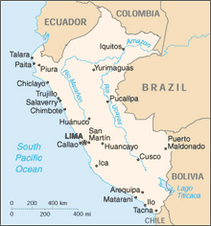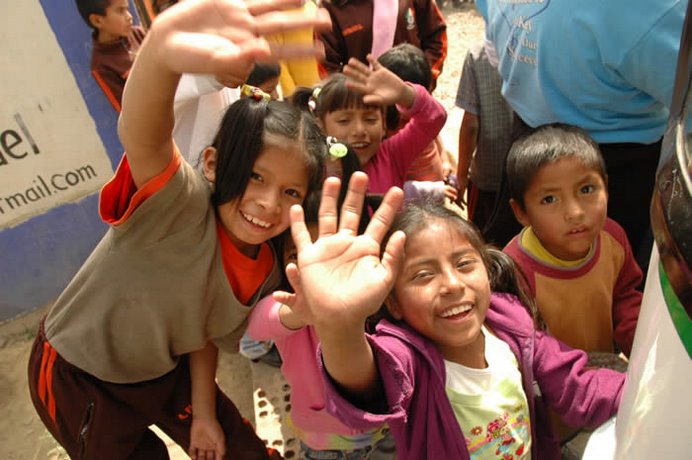http://en.wikipedia.org/wiki/Category:Fauna_of_Peru
http://es.wikipedia.org/wiki/Fauna_en_el_Perú
http://www.amazon-tours.com/tourism-bolivia/fauna.html

Lowland Tapir:
 -Can be found near water in the Amazon Rainforest.
-Can be found near water in the Amazon Rainforest.-Is an excellent swimmer and diver but also moves fast on land.
-Is recognized as an endangered animal species.
http://en.wikipedia.org/wiki/Lowland_Tapir
Jaguar:
 -Is the third-largest feline after the Siberian tiger and the lion, being on average the largest and most powerful feline in the Western Hemisphere.
-Is the third-largest feline after the Siberian tiger and the lion, being on average the largest and most powerful feline in the Western Hemisphere.-In the Brazilian Pantanal region found average weights of 100 kilograms (220 lb).
-Prefers large prey and will take deer, tapirs, peccaries, dogs, and even anacondas and caiman.
http://en.wikipedia.org/wiki/Jaguar
Hoffman's Two-Toed Sloth:
-Are found in the rainforest canopy in Central and South America.
-Spend most of their time in trees, though they may travel on the ground to move to a new tree, and are excellent swimmers.
-Their fur, unlike other mammals, flows from belly to top, not top to belly.
http://en.wikipedia.org/wiki/Hoffmann
Amazonian Manatee:

-Is the largest aquatic mammal in the Amazon Basin.
-Can reach a length of 3 meters and a weight of up to 300 kg.
-Is an endangered species.
http://en.wikipedia.org/wiki/Manatee
Giant Otter:
-Can reach up to 6 ft (1.8 m) in length, and weigh 76 lb (34 kg) in weight.
-Is one of the largest predators of its region.
-Feeds mainly on fish, such as catfish, piranha, and perch, but will also feed on crabs, small caimans, and snakes, including small anacondas.
-Is an endangered species.
http://en.wikipedia.org/wiki/Giant_otter
Capybara:  -Is the largest of living rodents
-Is the largest of living rodents
-Full-grown capybaras reach 105 to 135 cm (40 to 55 inches) in length, and weigh 35 to 65 kg (75 to 140 lbs).
-Spend most of their life in water.
-Their ears, eyes, and nostrils are on the top of its head because it spends much of its time in water.
http://en.wikipedia.org/wiki/Capybara
Howler Monkey:
-Are among the largest of the New World monkeys,
-Their name comes from their distinctive loud barking whoop they make, which can be heard over considerable distances.
-They rest about 80 percent of the time and are considered the least active of all monkeys.
http://en.wikipedia.org/wiki/Howler_monkey
Birds:
Macaw:
-Is the largest bird from tropical regions.
http://library.thinkquest.org/04oct/02004/pages/macaw.htm
Toucan:
 -Is frugivorous (fruit-eating), but will take prey such as insects and small lizards.
-Is frugivorous (fruit-eating), but will take prey such as insects and small lizards.
http://en.wikipedia.org/wiki/Toucan
http://library.thinkquest.org/04oct/02004/pages/toucan.htm
Reptiles and Amphibians:
Amazonian Rainforest Caiman:
-Is a very large reptile, often reaching four meters long.
-Is nocturnal.
-It's diet consists of fish, reptiles, and mammals, such as the capybara.
http://library.thinkquest.org/04oct/02004/pages/caiman.htm
Poison Dart Frogs:
-Live on the rainforest floor and are active in the daytime.
-About two and a half grams of the poison dart frog’s poison could kill a 150 pound human.
-Generally range between ½ an inch to 2 inches.
http://library.thinkquest.org/04oct/02004/pages/frog.htm
Green Anaconda:
 -Have been reliably reported in the 9 metre range (30 feet) in length.
-Have been reliably reported in the 9 metre range (30 feet) in length.
-can weigh 551 pounds) and have a diameter of more than 30 cm (11.8 inches), but averages 275-330 lbs.
-They typically feed on large rodents, tapirs, capybaras, deer, peccaries, fish, turtles, birds, sheep, dogs, and aquatic reptiles like caiman.
http://en.wikipedia.org/wiki/Anaconda
Insects:
Leaf Cutter Ant:
 -Are one of the primary consumers of vegetation in the Amazon.
-Are one of the primary consumers of vegetation in the Amazon.
-Do not actually feast leaves, but on fungus.
-Their large jaws are strong enough to break human skin.
http://library.thinkquest.org/04oct/02004/pages/ant.htm
Rhino Beetles:
-Are the strongest creature on earth, able to support 850 times its own weight.
http://library.thinkquest.org/04oct/02004/pages/beetle.htm
Bird Eating Spider:
-Have up to a 30 centimetre (12 in) long leg span when fully extended and can weigh over 120 grams.
-Females have an average life span of 6 to 14 years.
-Is one of the few tarantulas which can capture and eat a full-grown mouse.
http://en.wikipedia.org/wiki/Bird_eating_spider

 -Aymara is an Aymaran language spoken by the Aymara of the Andes.
-Aymara is an Aymaran language spoken by the Aymara of the Andes. -Was the language of the Inca Empire, and is today spoken in various dialects by some 10 million people (Quechuas) throughout South America
-Was the language of the Inca Empire, and is today spoken in various dialects by some 10 million people (Quechuas) throughout South America -The aboriginal languages of Peru are spoken mainly in the central Andes and in the Amazon forests.
-The aboriginal languages of Peru are spoken mainly in the central Andes and in the Amazon forests.
 The Loreto region is divided into seven provinces:
The Loreto region is divided into seven provinces:


 Iquito:
Iquito:



 Boto or Pink River Dolphin - Is a freshwater river dolphin endemic to the Amazon River. Largest of river dolphins. The 1994 and 200 IUCN Red List of Threatened Species classified it as vulnerable.
Boto or Pink River Dolphin - Is a freshwater river dolphin endemic to the Amazon River. Largest of river dolphins. The 1994 and 200 IUCN Red List of Threatened Species classified it as vulnerable.

